|
|
The Attribution
Guide to
1974 Canadian
Nickel Dollar Varieties
by Ken Potter -- NLG
(All photos by Ken Potter unless otherwise noted)
Originally presented in World Coin News
August 2000
Copyright Ken Potter 2000
Last updated to include new information on 10/20/2018
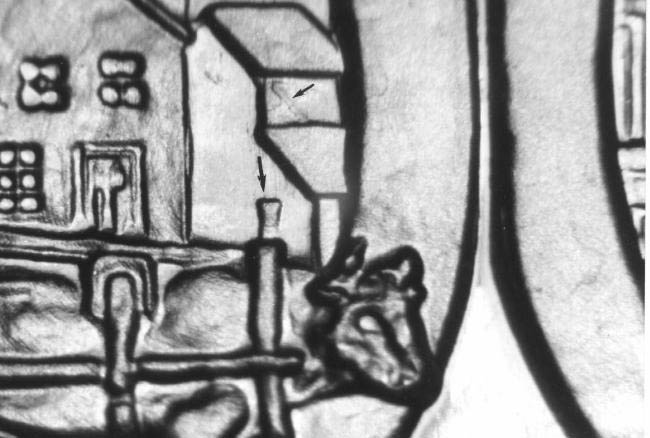
Click on Blue Underlined Text to View
the Images
Use the back arrow on your browser to return to this page
Collectors of Canadian coins may be familiar with the 1974 nickel dollar variety with the "extra yoke" above the ox as it is was included in the Charlton Standard Catalogue to Canadian Coins starting in 1996. However, what few collectors realize is that the one listed there is just one of many similar or related varieties.
The varieties are the result of hub doubling or what are commonly referred to as doubled dies. However, unlike most doubled dies, they exhibit doubling, (or "extra" images), restricted to the center of the design. Most hub doubled dies show the majority of doubling to best advantage on designs and characters closest to the rim.
With doubling restricted to such a small area, (primarily in the center region above the ox's back), I mistakenly mis-attributed them in earlier articles (of about 15 years ago - when only two varieties were known) as intentional engraving varieties. However, in 1983, Former Royal Canadian Mint, Master Engraver, Walter Ott took one look at an example of Reverse Die #1 (VCR#1/DDR#1) and explained the occurrence as being the result of a hubbing accident.
According to Ott, because a die blank starts out with a cone shaped face, (rather than flat as often presumed by collectors), it is possible to create doubling that is restricted to the center of the die if the hub is eased down and only kisses the tip of the cone. Ott suspected that the die blank was set into a hubbing press at a tilt. According to Ott, as the hubbing press operator eased down the hub (known as a "punch" in Canada) with the hydraulic press, the tilt was noticed just as the hub started to impress its image into the cone shaped tip. The hub was then backed off and the die blank reset into proper position. Impression(s) to follow were off register with the first impression and thus the resultant doubled die.
It should be pointed out that it could have been the hub that was tilted and this is perhaps the reason so many dies were affected in this manner.
While I believe Ott's explanation is sound for at least several of the earlier listings, (though the sequence of events could have varied), we shall see that some of the later listings are not so easily explained by this theory. In fact Die#6, #7 and #11 display secondary images that seem totally unrelated to the primary image, yet I have a strong gut feeling these irregularities are due to the hubbing process. As far fetched as it may sound, I suspect that some of these varieties may exhibit a composite doubling involving two entirely different designs.
Consider for a moment what could happen if an official inside the Mint made a decision to try to salvage previously rejected die blanks with what they felt were minor problems. Perhaps somebody felt that rejected die blanks involving a bit of design in the tip of the cone (rejected due to tilts or other reasons) could be salvaged and that the tiny areas of design would be obliterated by the full impressions of later hubbings.
If such an attempt were made, even obverse dies and dies produced in earlier years with different designs could have been re-impressed with the 1974 nickel dollar design hubs. This theory obviously needs more study but it is food for thought.

VCR#1/DDR#1
1974 $1 VCR#1 -- Our first photo depicts the original discovery piece that got the ball rolling and led to the discovery of all to follow. It exhibits an "extra yoke" directly above the normal yoke on the ox's back, just behind the shoulders. You can also see an extra portion of the lowest tier of the roof on the building directly above, floating within the middle tier.
This is a proof-like strike that is listed in the Variety Coin Register as VCR#1/DDR#1. It can be found in both sets and as cased singles. It was discovered by Maurice Larivére and is quite rare. I would guess that its value is at least triple the value of the business strike listed in the standard catalogue.
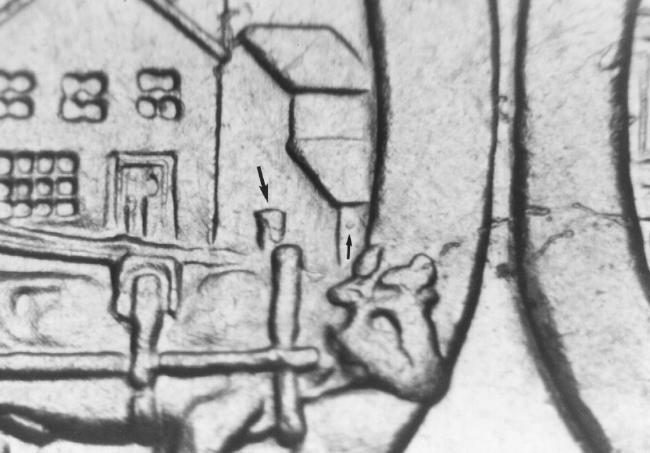
VCR#2/DDR#2
Our second variety is listed as VCR#2/DDR#2 and is a business strike that I discovered in pocket change sometime in the early 1980s. It is similar to VCR#1, but the "extra yoke" is located to the northwest of the normal yoke. There is also a slight trace of the high point of the ox's ear floating free on the side of the building. This is the variety now featured in the standard catalogue and the one most frequently encountered. Of interest is that coin specialist Rob Murray, who has had several of these, noted at at least some have a minor CCW rotated die.
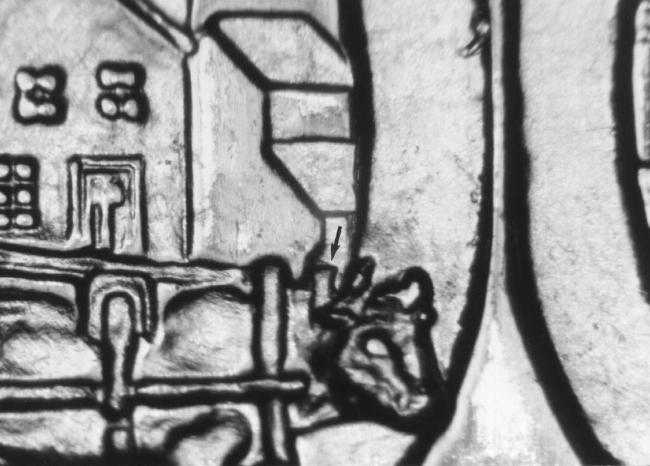
VCR#3/DDR#3
VCR#3/DDR#3 is a proof-like variety that was discovered by Garland Chapman in the early 1980s. It exhibits an "extra yoke" between the normal yoke and ox's ear. It is a bit harder to detect than the first two varieties as it is intermingled with other similarly sized design elements, pointing to the fact that one must look closely if all is to be found within this essentially busy design. Though this variety has been known for over 15 years, to the best of my knowledge, there are only three examples known. The piece shown was found as a cased single by reader Jerry Kennison.
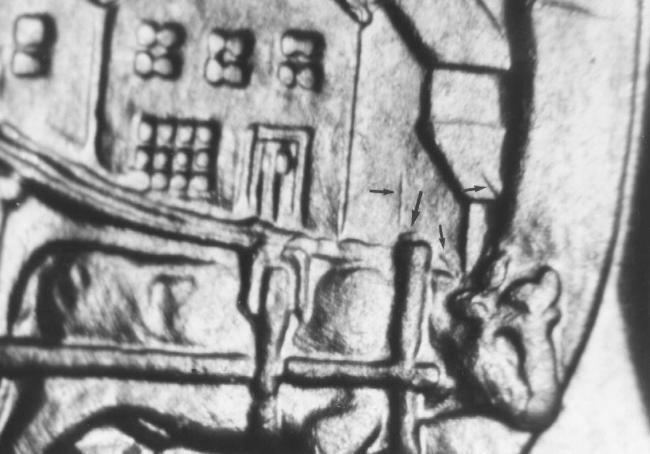
VCR#4/DDR#4
Dan Gosling has a long string of varieties to his credit starting with VCR#4/DDR#4 which is a business strike that he submitted in August of 1994. This is a stubby version of an "extra yoke" (over the normal yoke) that again points out that one must look close. Also notice the thin vertical line on the side of the building just over the "extra yoke." This is actually an impression of the lip or high point from the edge of the right side of the building to the left. There is also a portion of "extra roof" in the lowest tier of the roof and an unidentified image on the building between the yoke and ox's ear.
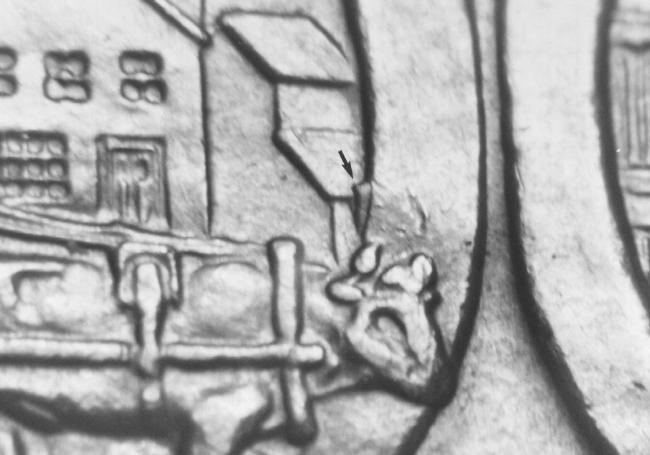
VCR#5/DDR#5
Gosling's next discovery is another business strike listed as VCR#5/DDR#5. It exhibits an "extra yoke" over the ox's ear on the side of the building and roof.
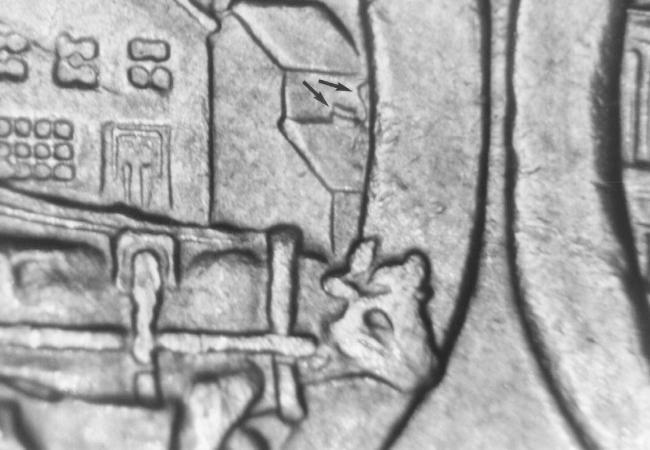
VCR#6/DDR#6
VCR#6/DDR#6 is somewhat of a mystery. This coin features unidentified secondary images on the roof and building above the ox.. The variations are too perfect in "design" to be a die break and don't appear to be the result of clashed dies. I'm fairly well convinced this is the result of hubbing and will list it under that designation (as a doubled die) unless proven otherwise. This business strike was submitted by Dan Gosling in August of 1994.
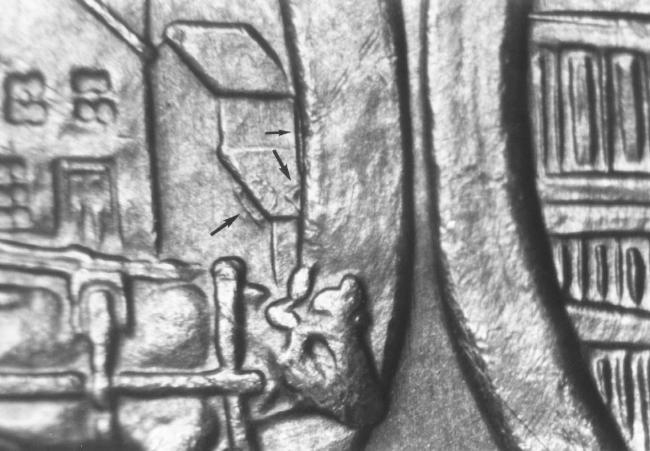
VCR#7/DDR#7
The mystery continues with yet another Gosling submission listed as VCR#7/DDR#7. This business strike shows a D-shaped raised area tilted left and overlapping the side and lower roof of the building furthest to the right in the "old city" (the "old city" is within the first 0 of the centennial number 100 that dominates the reverse and acts as the framework for the old and new cities). To the east of the "D" is an arrow-head shaped raised area protruding out from under the 0 and pointing left; above is a long thin elliptical shaped raised area tucked in between the building and the inside border of the 0.
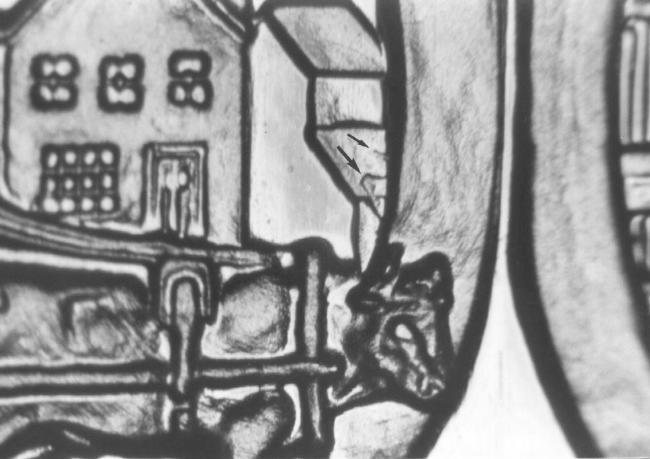
VCR#8/DDR#8
VCR#8/DDR#8 is a proof-like strike that shows what appears to be an "extra" portion of the upper northwest corner of the lowest tier of the roof floating free and overlapping a portion of the roof and side of the building above the ox's ear. Above this is another spike-shaped image which may represent the same from an earlier and weaker hubbing. This is a proof-like variety first reported to by Dan Gosling in 1995; later finds have been reported by Ron Hoskins in 1996 and Brian Dufour in 1997. Bob Didur of Michigan reported finding one in a Seven-Coin Specimen Set in 2009 that he had owned since 1974.
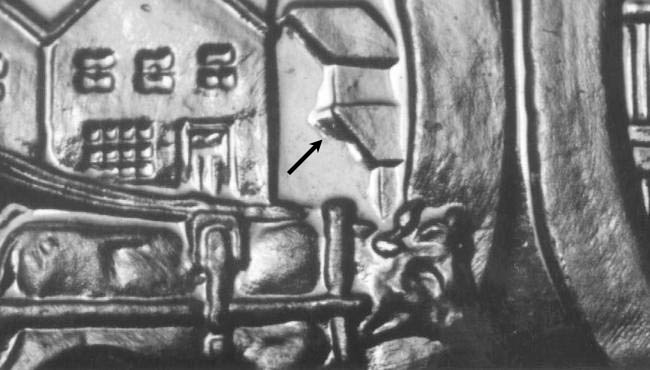
VCR#9/DDR#9
VCR#9/DDR#9 shows doubling with the secondary image shifted west on the northwest corner of the lowest tier of the roof on the building furthest to the right. This is another proof-like strike reported by Dan Gosling in January of 1996. Photo courtesy of Dan Gosling.\

VCR#10/DDR#10
VCR#10/DDR#10 is similar to VCR#9 but shows as a triangular raised "design" next to the lower roof on the building furthest to the right (as described for VCR#9). Examples of this proof-like variety have been reported by Dan Gosling in August of 1995 and Brian Dufour in September of 1997.

VCR#11/DDR#11
Brian Dufour was first to report VCR#11/DDR#11 which is an interesting proof-like variety that shows numerous raised images on the side of the building in the areas described for the previous varieties. One may want to just dismiss these "lumps" as die chips or tooling damage but the area in which they are found and there well-rounded formation, convinces me that this is a hubbing variety. This one was listed in February 1997.

VCR#12/DDR#12
Our variety is listed as VCR#12/DDR#12 shows little more than an arrow-head shaped raised area jutting out from under the 0 and pointing west on the middle tier of the roof on the building to the right. While it's not a particularly major variety and may just be a die chip, my comments for the variety above apply here too. The coin (and the photo) was submitted by Dan Gosling.
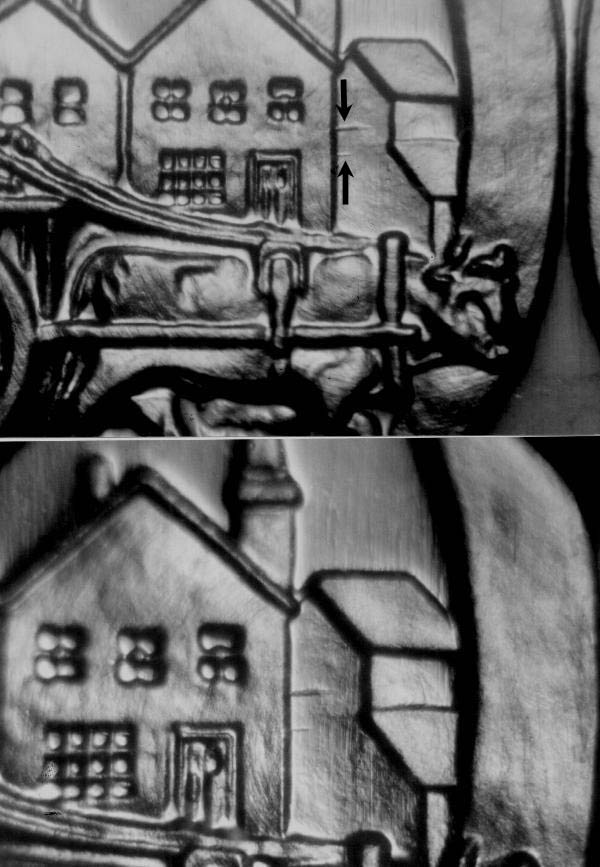
VCR#13/PDDR#13
Our next coin was discovered in a proof-like set by Tom Merritt of Ontario. It is listed as VCR#13/PDDR#13 and shows two parallel horizontal lines on the building above the ox. I'm not sure if this is a hubbing variety or die gouges but it sure is interesting enough to add to these listings and deserves more study. It was listed in August of 2002.
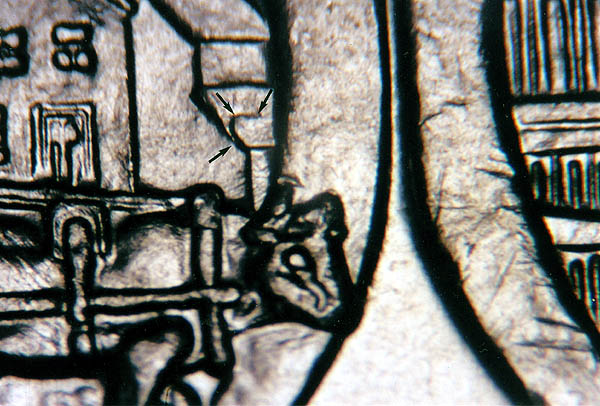
VCR#14/DDR#14
Credit goes to Ray Fishlock of Ontario for finding the next two 1974 Nickel dollar doubled die reverses. The first one shows what appears to be an "extra" portion of one of the tiers of the roof overlapping on top of the lowest level as pointed out by the three arrows. It is a general business strike. I listed it in October of 2004 as VCR#14/DDR#14.
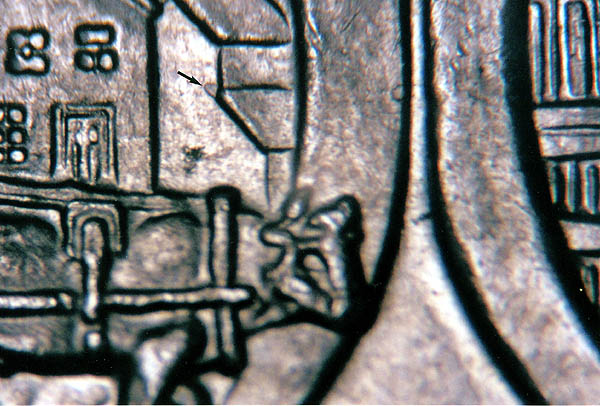
VCR#15/DDR#15
Fishlock's second submission shows as weak version of the triangular shaped forward portion of the sections of the roof behind it. It is also a business strike that I listed in October of 2004 as VCR#15/DRR#15.
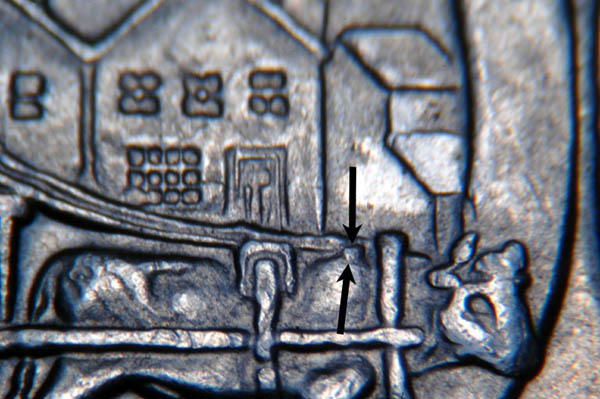
VCR#16/DDR#16
VCR#16/DDR#16
- Unlike
the business strike version that is listed in The Charlton Standard Catalog of
Canadian Coins that shows a prominent secondary yoke on the back of the ox, (our
VCR#2/DDR#2), this one has a stubby extra yoke to the southwest fairly
well-hidden in the design. This is probably why it took so long for it to be
discovered. However, once one knows where to look, it is easily
spotted. Terry Stark of Alberta was the first to report
it to the Variety Coin Register in March of 2008. It is listed
as VCR#16/DDR#16.
Note: After this variety was listed
in the Variety
Coin Register for Stark, I learned (and was able to confirm from written correspondence
and images), that the same variety had been sent to Bill Cross (publisher of The
Charlton Standard Catalogue of Canadian Coins) in 2005 for possible inclusion in
the catalog. Stark still gets the credit for being the first to submit it to the
VCR but I do want to acknowledge other credits when they can be positively
verified such as was the case here.
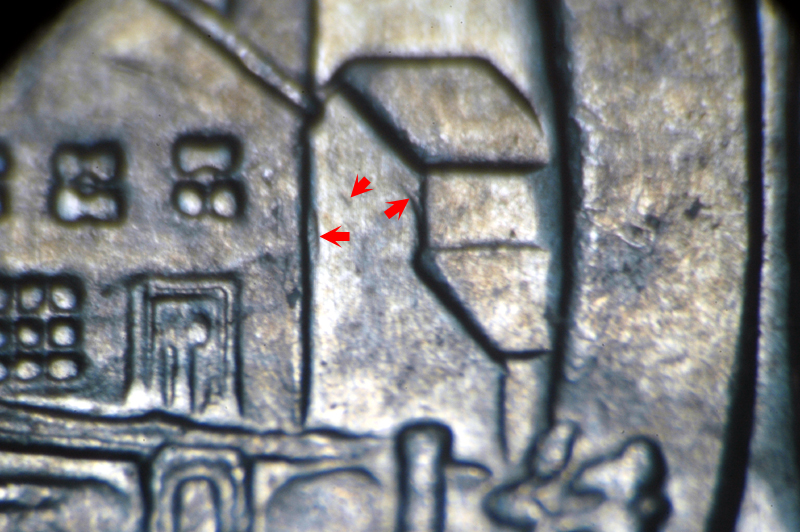
VCR#17/DDR#17
VCR#17/DDR#17. This one shows a bit of the building to the left doubled out to the east and a bit of the roof of the building to the right poking out to the northwest. A small raised area is located in between. Submitted by Roger Paulen of Sherwood Park Pennies December 2008.
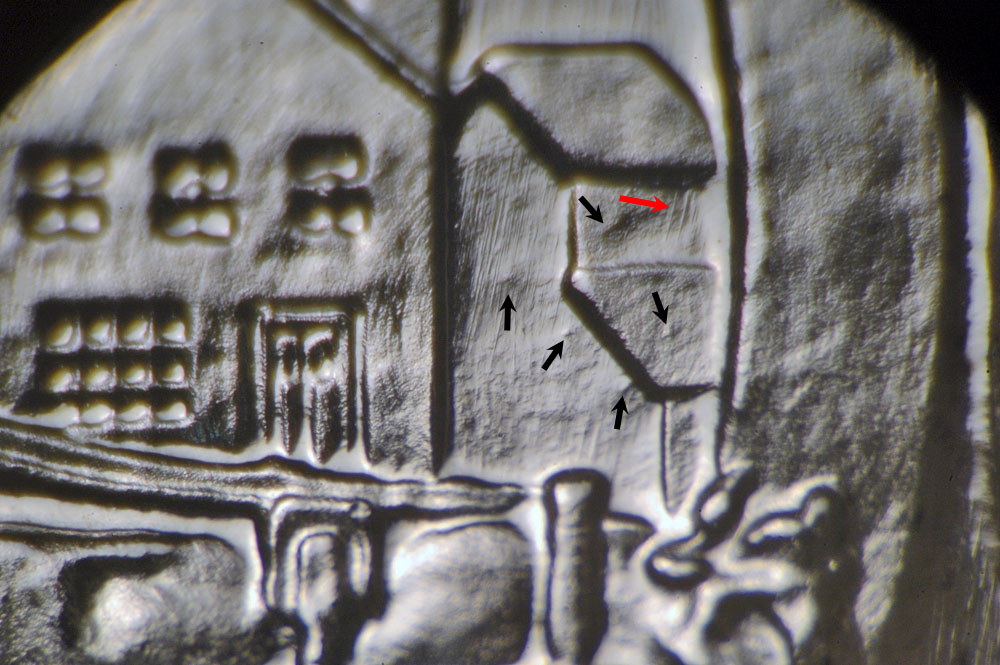
VCR#18/DDR#18.
VCR#18/DDR#18. Remnants of an earlier hubbing are pointed
out by arrows.
Submitted by John Kosakowski of MI November 25, 2012.
Note: Concentric Lathe lines show in central area of design and are strong
on all numismatic issues (Proof-Like and Specimen Strikes) and can be seen to a
greater or lesser degree on business strike (circulation coins). Red arrow
points to some obvious markers for this die. Others exist.
Ken Potter is the official attributer of world doubled dies for the Combined Organizations of Numismatic Error Collectors of America and for the National Collectors Association of Die Doubling. He also privately lists other collectable variety types on both U.S. and world coins in the Variety Coin Register. More information on either of the clubs or how to get a coin listed in the Variety Coin Register may be obtained by sending a long self addressed envelope with 99c postage or by contacting him via email at KPotter256@aol.com.. An educational image gallery may be viewed on his website at Ken Potter's Variety Vault

Numismatist Since 1959 ~ Serving
the Collector Since 1973
CONECA's Longest Serving Doubled Die Attributer
Member of: ANA-LM CONECA-LM NLG NCADD-FM
MSNS-LM
NWDCC RCC WBCC BBCC IASAC